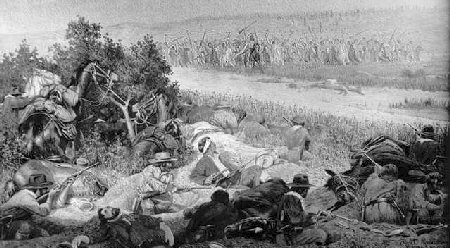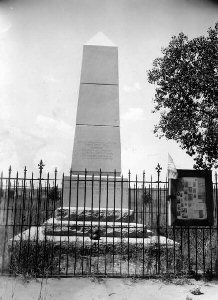

The Beecher Island Battle - Harpers Monthly 1895
The Beecher Island Battlefield
The Beecher Island battlefield is in eastern Yuma County, Colorado, where County Road KK crosses the Arikaree River some 16 miles south of Wray and 9 miles north of US Highway 36. See Lee's county map.
The Forsyth Scouts and the Battle
Fifty civilian scouts, to be under the command of Bvt. Col. George Forsyth of the 9th Cavalry, were recruited at Fort Harker (near Ellsworth, Kansas), Fort Hays and Fort Wallace in late August and early September 1868 to help counter Arapahoe, Cheyenne and Sioux raids on the Kansas Pacific railroad construction camps then near Fort Wallace, Kansas, attacks on travelers on the Solomon and Smoky Hill stage routes to Denver and raids on settlers in western Kansas and southwestern Nebraska. Lt. Fred Beecher, 3rd Infantry, was detailed to the scouts to be second in command.
On September 10th the scouts were dispatched from Fort Wallace to counter an Indian raid near Sheridan, Kansas. From the 11th to the 16th the scouts trailed a small party of raiders north and west to what is now the Beecher Island Battlefield on the Arikaree River where they camped the evening of the 16th.
Sunrise on the morning of the 17th was greeted with the sound of war cries and gunfire when the scouts were attacked. Badly outnumbered, Col. Forsyth directed his men to an nearby island in the shallow river to establish a defensive position. After a sharp two day battle during which Roman Nose, a war leader of the Northern Cheyenne, was killed the fight settled down to a siege with the scouts still dug in on their island surrounded by approximately 750 Cheyenne and Sioux braves. Four scouts were killed on the 17th and 18th; Lt. Fred Beecher, Acting Surgeon J.H. Mooers, George W. Culver and William Wilson. About 20 others were wounded including Col. Forsyth who had a head wound, a broken leg and a gunshot wound in the other thigh. With their food exhausted the scouts were soon reduced to a ration of spoiling horse meat and water.
Forsyth dispatched two-man messenger parties to walk to Fort Wallace, some 75 miles southeast of the battlefield, during the nights of the 17th, 18th and 19th. The pair sent on the 18th were forced to return to the island when they couldn't find a way through the Indian picket lines. The other four scouts reached Fort Wallace within an hour of each other on the 22nd. Relief forces were immediately dispatched to the battlefield. The first to arrive was Company H, 10th US Cavalry, which reached Forsyth the morning of the 25th and found the battlefield empty except for debris from the fight and the surviving scouts. Scout Louis Farley died the same day from wounds received on the 17th and was buried on the battlefield along with the other four dead scouts.
By September 30, 1868 everyone was back at Fort Wallace where a sixth scout, Thomas O'Donnell, died November 18, 1868 in the Post Hospital from his wounds and was buried in the Fort Wallace Cemetery. By the end of the year the Forsyth scouts were disbanded.
Two companies of the 5th US Infantry, Fort Wallace, guided by Forsyth's chief scout Abner Grover, returned to the battlefield in December 1868 to recover the remains of the five scouts buried in September. The remains of George W. Culver and Louis Farley were recovered. However, the detail failed to recover the remains of Lt. Beecher, Surgeon Mooers and Scout William Wilson. Scouts Culver and Farley were re-interred in the Fort Wallace Cemetery. When the Fort Wallace military post closed in 1882, their remains were moved to the Fort Leavenworth Post Cemetery.
The Reunions, the Monuments and the Association

1905 Monument
In the late summer of 1898, as the 30th anniversary of the battle approached, Chalmer Smith and James J. Peate, of the Forsyth Scouts, both living at Beverly, Kansas, decided to return to Colorado and see if they could locate the island battlefield. They invited another of the scouts, Harry H. Tucker of Oklahoma, to join them. With the help of Frank and Charles Reeck, who had settled near Beecher in 1876 and remembered all the horse skeletons still on the battlefield, the three veterans placed a sandstone cairn with a sandstone slab engraved "Battle of Beecher Island, September 17, 1868," marking the site.
The battle veterans 30th anniversary visit prompted the Vernon and Wray posts of the Grand Army of the Republic (GAR), civil war veterans, to hold a joint meeting at the site in September 1899. At that first meeting it was decided to form a group to create a memorial and park at the battlefield as a place to hold annual reunions of veterans, their families and friends. In the fall of 1899 the Beecher Island Park and Memorial Association was incorporated, with Major William R. Hayes named as president of a three man board tasked to acquire the battlefield site for a park and raise funds for a monument. In 1900 the Association spent $100 to erect a wooden monument to symbolize the granite column they hoped to place. The Association held reunions in 1900 and again in 1901.
At the 1901 meeting the veterans voted to disband the board and the existing association and form a new one. Out of that meeting the Beecher Island Battle Memorial Association was created with a twelve man board.
In 1902 a bill was introduced in the U.S. Congress to deed 120 acres of Federal land at the site of the battlefield to the Association. A similar bill was introduced in the Colorado State Legislature to deed another 120 acres of adjoining State land. Both bills were approved and the patents issued September 11, 1905.
In August 1903 the Association was again reorganized and reincorporated but retained the 1901 name.
The Colorado and Kansas Legislatures were petitioned to furnish $5,000 toward building a suitable joint monument on the battlefield. In early 1905 both appropriations were made and in April 1905 the Association asked for bids for a $5,000 monument. The contract was granted in May 1905 to the Denver Marble and Granite Company for the monument that was dedicated at the 1905 Reunion. Many of the surviving scouts attended the dedication. Description of the 1905 Monument.

Early Beecher Reunion - G. Renzleman Photo.
Early reunions were held entirely in the open or under large canvas tents and lasted almost a week. In 1925 the Colorado Legislature appropriated $15,000 to build the Memorial Association building on the site. The funded design was about 35 feet short of what was thought to be required to seat all those then attending the reunion so it was decided to erect the brick building with an open end closed by a temporary board wall to allow future expansion. That decision lead to the distinctive brick and board design so evident in photographs.
The 1935 Arikaree flood swept away the original monument. Only a part of the base was recovered and reinstalled as part of the current monument relocated to higher ground in front of the Association building. The engraved marble portion of the current monument still shows water stains from the flood. Since the upper marble section of the 1905 monument listing the scouts who were wounded and killed in the battle was never recovered, the current monument is missing the names of about half of the scouts.
The Annual Beecher Island Reunions continue to be held on the third weekend of September each year hosted by the Beecher Island Memorial Association.
The Association's mailing address is: Beecher Island Memorial Association, 21776 County Road KK, Wray, CO 80758.
See Beecher Photographs for Coston Studio photographs of many of the events outlined above.
Transcription of the engraving on the Beecher Island Battle 1905 Monument.
For a more detailed summary of the battle including a complete list of scouts see my The Forsyth Scouts. Also see General George A. Custer's 1872 account of the battle as published in the San Francisco Chronicle.
A 1907 account of the Beecher Island Battle transcribed from A Souvenir of Wray and Vernon.
There is an account of the battle from the Company H, 10th Cavalry Regiment (Buffalo Soldiers) perspective on the CO H/10th Cav Reenactors website.
| Main Page | Site Index | Photos | On Line Data |
© 2008 Lee Zion